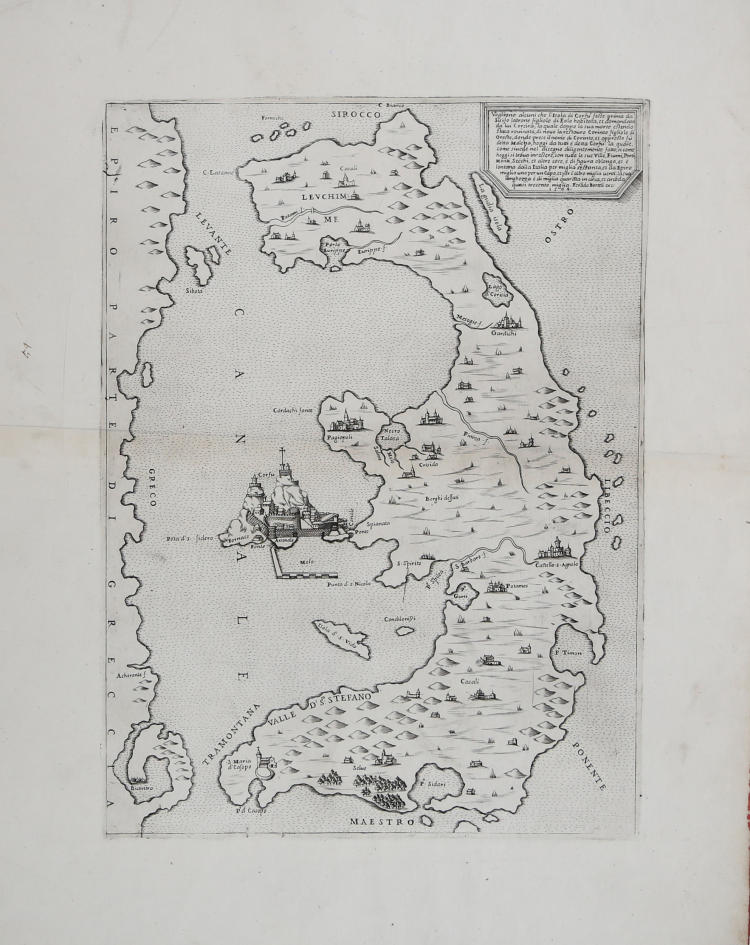




| Reference: | S30341 |
| Author | Paolo FORLANI |
| Year: | 1564 |
| Zone: | Corfu |
| Printed: | Venice |
| Measures: | 280 x 376 mm |



| Reference: | S30341 |
| Author | Paolo FORLANI |
| Year: | 1564 |
| Zone: | Corfu |
| Printed: | Venice |
| Measures: | 280 x 376 mm |
Title and description in the upper right cartouche: Vogliono alcuni che l’Isola di Corfu fosse prima da Sisifo latrone figliolo di Eolo habitata, et domandata da lui Corcira; la quale doppo la sua morte essendo stata rovinata, di novo la restauro Corinto figliolo di Oreste, donde prese il nome di Corinto, et appresso fu detta Malena, hoggi da tutti e detta Corfu: la quale, come sivede nel disegno diligentemente fatto, si come hoggi si trova in essere, con tutte le sue Ville, Fiumi, Porti, Monti, Secchi, et altre cose, e di figura oblonga, et e lontana dalla Italia per miglia sessanta, et da Epiro miglio uno per un Capo, et per l’altro miglia venti, la sua longhezza e di miglia quara[n]ta in circa, et circo[n]da quasi trecento miglia. Fera[n]do Berteli exc: 1564.
Etching with engraving, signed in the cartouche Fera[n]do Berteli exc: 1564. A fine impression on contemporary laid paper, with original margins, very good conditions.
The first Venetian derivation of the prototype of the Monogrammist PS (1537, Bifolco-Ronca Tav. 726) is due to the collaboration between Paolo Forlani and Ferrando Bertelli. The map this time is oriented with the southeast at the top and is devoid of the depictions with the camps of the Turks, thus leaving the center of the empty card and with very little toponymy. Presents the landscape with three-dimensional inhabited centers but without details realistic (except for the city of Corfu). The orography is typical of Forlani, represented in "heap of mole", while hydrography it is rather elementary. At the center of the map, on the east coast of the island, the city of Corfu is highlighted off the scale, with a perspective view of the fortified citadel and the port. The map was very successful, as evidenced by the large number of copies present in the sixteenth century collections and was also the source for the small map that Abraham Ortelius inserted into the “Theatrum Orbis Terrarum” (1570). Even if it’s not signed, the map was ascribed to Forlani by D. Woodward for obvious stylistic reasons.
Bibliografia
Bifolco-Ronca, Cartografia e Topografia Italiana del XVI secolo, p. 1500, tav. 727; Tolias (2011): n. 0083; Tooley (1939): n. 165; Zacharakis (1992): n. 223; Zacharakis (2009): n. 354; Woodward (1990): n. 27; Woodward (1992): n. 33.
Paolo FORLANI (Attivo a Venezia seconda metà del XVI secolo)
|
Paolo Forlani, a native of Verona, opened his own chalcographic workshop in Venice, Al segno del pozzo, in 1560, as reflected in some of his works. From 1566 he was active in Merzaria al segno della colonna and from 1569 in Merzaria al segno della nave. Forlani had business relationships with the major publishers of cartographic material of the time, among them Antonio Lafreri, the Bertelli family, and others. In addition to being a talented engraver, he was also quick to execute, a quality that enabled him to work for different publishers at the same time, and to execute a large amount of work. Woodward attributes about one hundred works to Forlani, most of which, however, are unsigned. Between 1560 and 1567, Forlani collaborated with Ferrando Bertelli, for whom he engraved about ten copperplates, with Camocio, Bolognino Zaltieri, and with Claudio Duchetti, for whom he engraved some maps. For his professional activity, however, the collaboration with Giacomo Gastaldi, for whom he engraved thirteen maps, was very important and valuable. In 1567 Forlani published and traded his work Il primo libro delle città et fortezze principali del mondo, whose branches later passed to Bolognino Zaltieri. It is likely that Forlani died during the plague that spread through Venice from 1575.
|
Paolo FORLANI (Attivo a Venezia seconda metà del XVI secolo)
|
Paolo Forlani, a native of Verona, opened his own chalcographic workshop in Venice, Al segno del pozzo, in 1560, as reflected in some of his works. From 1566 he was active in Merzaria al segno della colonna and from 1569 in Merzaria al segno della nave. Forlani had business relationships with the major publishers of cartographic material of the time, among them Antonio Lafreri, the Bertelli family, and others. In addition to being a talented engraver, he was also quick to execute, a quality that enabled him to work for different publishers at the same time, and to execute a large amount of work. Woodward attributes about one hundred works to Forlani, most of which, however, are unsigned. Between 1560 and 1567, Forlani collaborated with Ferrando Bertelli, for whom he engraved about ten copperplates, with Camocio, Bolognino Zaltieri, and with Claudio Duchetti, for whom he engraved some maps. For his professional activity, however, the collaboration with Giacomo Gastaldi, for whom he engraved thirteen maps, was very important and valuable. In 1567 Forlani published and traded his work Il primo libro delle città et fortezze principali del mondo, whose branches later passed to Bolognino Zaltieri. It is likely that Forlani died during the plague that spread through Venice from 1575.
|